 Stanley
Arms on Stalls in Manchester cathedral
Stanley
Arms on Stalls in Manchester cathedral Stanley
Arms on Stalls in Manchester cathedral
Stanley
Arms on Stalls in Manchester cathedral[This is extracted from Vol 35 Transactions Lancashire and Cheshire Antiquarian Society 1917 pp30/34]
NOTE A.
A good deal of confusion has existed in regard to this point of heraldry, and also in regard to certain members of the Stanley family of Lathom at this time, notably Sir Thomas Stanley, K.G., first Baron Stanley, who died in 1458, and Sir Thomas Stanley, K.G., his son, second Baron Stanley, who was created Earl of Derby in 1485, after the battle of Bosworth, and died in 1504. To these must be added two James Stanleys, both of whom were wardens of the College of Manchester, namely, James, brother of the last named, who was warden from 1481 to 1485, and James, his nephew, afterwards Bishop of Ely, who succeeded him in the wardenship and was sixth son of the above Thomas Earl of Derby.
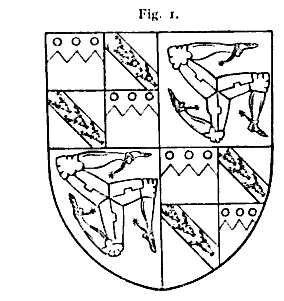 Sir
Thomas, first Baron Stanley, was son and heir of John Stanley, of Lathom and
Knowsley, and Isabel, daughter of Sir William Harrington, K.G. He married Joan,
daughter and co-heir of Sir Robert Goushill, of Hoveringham, co. Notts. His
Garter shield (fig. i) is-quarterly: .1 and 4, or, on a chief indented azure,
three plates argent, LATHOM, h. quartering argent on a bend azure three bucks'
heads caboshed or, STANLEY; 2 and 3, Gules 3 legs in armour flexed in triangle,
or, for the ISLE OF MAN. It is worth noting that this shield is neither inescutcheoned
nor impaled; moreover, in the first and fourth grand quarters it will be seen
that Lathorn, not Stanley, occupies the prior position. The same order occurs
in an earlier Stanley armorial on the fine boss in the cloisters of Canterbury
Cathedral assigned to Sir John Stanley, K.G., who died in 1414.* This illustrates
the family pride in the Lathom alliance, as also in their honour as Lords of
Man, the arms of which latter are given on a separate shield on the boss mentioned;
and later, for some generations, they appear in second and third grand quarters.
As in no instance the stall plate proper of a Knight of the Garter exhibits
an impalement we have here the Knight's personal arms only. The Goushill arms
on the first Baron Stanley's shield would, in the ordinary course, be inescutcheoned,
Joan being an heiress, but in any case they could only be quartered by his heir.
Sir
Thomas, first Baron Stanley, was son and heir of John Stanley, of Lathom and
Knowsley, and Isabel, daughter of Sir William Harrington, K.G. He married Joan,
daughter and co-heir of Sir Robert Goushill, of Hoveringham, co. Notts. His
Garter shield (fig. i) is-quarterly: .1 and 4, or, on a chief indented azure,
three plates argent, LATHOM, h. quartering argent on a bend azure three bucks'
heads caboshed or, STANLEY; 2 and 3, Gules 3 legs in armour flexed in triangle,
or, for the ISLE OF MAN. It is worth noting that this shield is neither inescutcheoned
nor impaled; moreover, in the first and fourth grand quarters it will be seen
that Lathorn, not Stanley, occupies the prior position. The same order occurs
in an earlier Stanley armorial on the fine boss in the cloisters of Canterbury
Cathedral assigned to Sir John Stanley, K.G., who died in 1414.* This illustrates
the family pride in the Lathom alliance, as also in their honour as Lords of
Man, the arms of which latter are given on a separate shield on the boss mentioned;
and later, for some generations, they appear in second and third grand quarters.
As in no instance the stall plate proper of a Knight of the Garter exhibits
an impalement we have here the Knight's personal arms only. The Goushill arms
on the first Baron Stanley's shield would, in the ordinary course, be inescutcheoned,
Joan being an heiress, but in any case they could only be quartered by his heir.
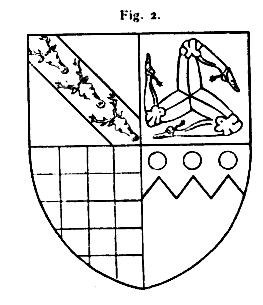 Accordingly,
in the simple Garter plate (fig. 2) of Thomas, second baron and first earl,
son and heir of the foregoing, this quarter appears. Here the order is (1) STANLEY,
(2) MAN, (3) WARENNE (for GOUSHILL.), and (4) LATHOM. The Earl's arms are more
amply set forth in the impalement on the shield (fig. 3) at the east end of
the tomb of the Lady Margaret, Countess of Richmond and Derby, at Westminister
Abbey, who was his second wife. Here the Goushill alliance is indicated in the
third quarter of the first and fourth grand quarters, an inescutcheon of honour
now appearing for MONTALT. (2)
Accordingly,
in the simple Garter plate (fig. 2) of Thomas, second baron and first earl,
son and heir of the foregoing, this quarter appears. Here the order is (1) STANLEY,
(2) MAN, (3) WARENNE (for GOUSHILL.), and (4) LATHOM. The Earl's arms are more
amply set forth in the impalement on the shield (fig. 3) at the east end of
the tomb of the Lady Margaret, Countess of Richmond and Derby, at Westminister
Abbey, who was his second wife. Here the Goushill alliance is indicated in the
third quarter of the first and fourth grand quarters, an inescutcheon of honour
now appearing for MONTALT. (2)
It may be asked why the fourth coat of the Stanley shield here is WARENNE, and not GOUSHILL., seeing that Joan was co-heir of her father. The reason is that through her mother Elizabeth, daughter and co-heir of Thomas, Earl of Arundel, she inherited a more illustrious patrimony and arms, including parcel of the ancient Earldom of Surrey, which in 1347, on the death of John de Warenne, devolved to Edward Fitz Alan, Earl of Arundel, in right of his wife Alice, sister to the former. Thenceforward the FitzAlans quartered the Warenne cheeky on their arms.
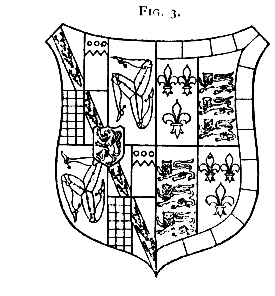
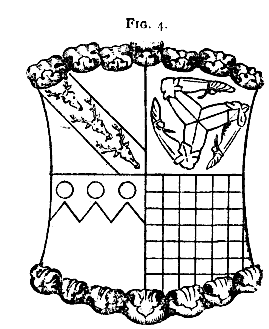 Of
the above-mentioned authoritative shields of the Earl of Derby, our Warden's
father : First, the simple quarterings at Windsor; and secondly, the fuller
blazon at Westminster; either might have been used, duly "differenced"
for a younger son, by our Warden, the Bishop; the simpler one, indeed, is identical
in its quarterings with the carving (fig. 4) on the Warden's stall, only excepting
the positions of the third and fourth quarters, which are reversed. Had the
Warden's ancient tomb in St. John's Chapel not been tampered with and despoiled
of its heraldic accompaniments, of which no record has been preserved, the fuller
blazon as shown at Westminster might possibly have been exemplified here also.
It so happens that no arms of the Bishop are to be found now at Ely; and Bedford
in his Blazon of Episcopacy, second edition, 1897, p. 45, appears to
err in omitting the Warenne coat from the Bishop's shield. But the full arms
(fig. 5) formerly existed on a carved mantelpiece erected by the Bishop at his
episcopal Manor of Somersham, and a copy of this carving was made by William
Cole, of Bletchley, in the eighteenth century; on examining which it becomes
apparent that the Bishop used the full arms of his father as they appear at
Westminster, with the addition of the Garter, and, apparently, a Crescent for
difference.(4) And that these quarterings continued to be used may be seen from
the arms of Thomas Stanley (son of Lord Strange of Knockyn), second Earl of
Derby, and grandson of the first Earl; with which should be compared the seal
of Edward, third Earl of Derby. The former (fig. 6) are here shown, taken from
a carving at Mold Church, Flints.; the latter is illustrated in David Powel's
Chapter House (Westminster) Seals vol. iv., p. 63.}
Of
the above-mentioned authoritative shields of the Earl of Derby, our Warden's
father : First, the simple quarterings at Windsor; and secondly, the fuller
blazon at Westminster; either might have been used, duly "differenced"
for a younger son, by our Warden, the Bishop; the simpler one, indeed, is identical
in its quarterings with the carving (fig. 4) on the Warden's stall, only excepting
the positions of the third and fourth quarters, which are reversed. Had the
Warden's ancient tomb in St. John's Chapel not been tampered with and despoiled
of its heraldic accompaniments, of which no record has been preserved, the fuller
blazon as shown at Westminster might possibly have been exemplified here also.
It so happens that no arms of the Bishop are to be found now at Ely; and Bedford
in his Blazon of Episcopacy, second edition, 1897, p. 45, appears to
err in omitting the Warenne coat from the Bishop's shield. But the full arms
(fig. 5) formerly existed on a carved mantelpiece erected by the Bishop at his
episcopal Manor of Somersham, and a copy of this carving was made by William
Cole, of Bletchley, in the eighteenth century; on examining which it becomes
apparent that the Bishop used the full arms of his father as they appear at
Westminster, with the addition of the Garter, and, apparently, a Crescent for
difference.(4) And that these quarterings continued to be used may be seen from
the arms of Thomas Stanley (son of Lord Strange of Knockyn), second Earl of
Derby, and grandson of the first Earl; with which should be compared the seal
of Edward, third Earl of Derby. The former (fig. 6) are here shown, taken from
a carving at Mold Church, Flints.; the latter is illustrated in David Powel's
Chapter House (Westminster) Seals vol. iv., p. 63.}
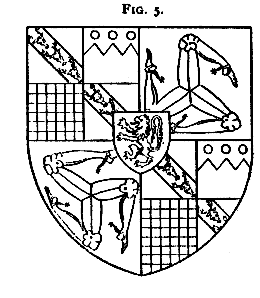 |
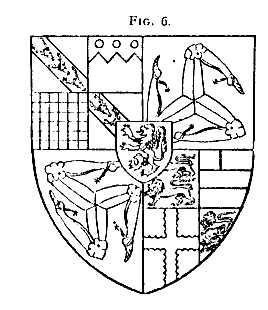 |
A reproduction of Cole's original sketch, entirely accurate so far as its drawing is concerned, yet nevertheless curiously misleading, was given in a paper on " The Stanley Chapel," by the late Rev. E. F. Letts, in the Transactions of the Lancashire and Cheshire Antiquarian Society, vol. vi., p. 163, &c. An ambiguity, which also appears in the original sketch, will be noticed in the third quarter of the first and fourth grand quarters of the shield of arms therein depicted. This ambiguity has puzzled several, including evidently Mr. Letts himself. A close examination of Cole's sketch, however, and of the accompanying notes which appear on the same page, explains the difficulty. Cole first saw the carving in 1759, and desired to obtain it, but, being unable to gain immediate possession of it, he contented himself with making his sketch and recording some notes. The sketch and notes made at this time are in somewhat faded ink. Fifteen years later the carved mantelpiece came into Cole's possession, and the careful antiquary, as was his habit, made a note of the fact. The ink and writing of the additional note contrast in evident manner with the original, and it is quite clear that the doubtful quarterings on the shield, both in the drawing and the copy, are the result of an alteration which Cole made at the same time. A reexamination of the carving convinced him of an error in his original sketch, in which he had given the third quarter Lathom, and he corrected it by drawing the Wareme " checky " over the previous lines, as is quite plain from the darker ink and more cramped pen here also. (See Brit. Mus. Additional MSS., 5830.)
1 See Archaeologia, vol. lxvi., p. 538.
2 My attention has been kindly called by Dr, Philip Nelson, F.S.A., to the tabards of the effigies of both knights which are now at Ormskirk Church, whither they were removed from Burscough Priory at the dissolution. Here also the Ovarenne quartering is seen on the Earl's tabard, but not on that of his father.
3 Cole mentions the Crescent Sable for " difference " in his note, but it is omitted in the drawing.
4 This MS. collection is now in the Manchester Free Reference Library.
|
|
||
|
|
||
|
Any comments, errors or omissions gratefully received
The Editor |
||